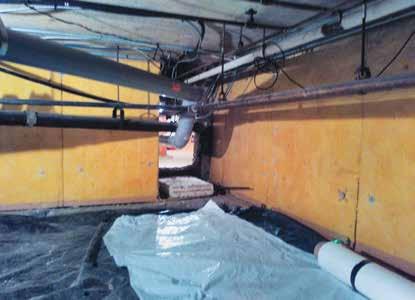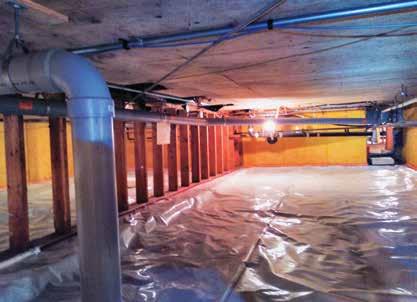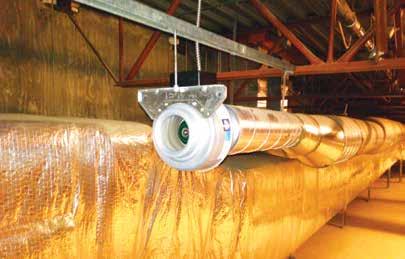
5 minute read
Radon gas and the impact of it in our schools
A newer-built structure with HVAC ducting running under the slab. IAQ could be as much of an issue as radon. The ground is cool and moist and the ducting inside is handling warmer air. Much the same as “the perfect storm".
Typical system with radon fan installed and exhausting from below the slab /membrane to the exterior. A typical example of poly just laid over soil, unattached, and unsealed. IAQ as well as radon are the issues here.


By Paul Muntak
The term “radon” seems fairly new, or even unheard of to many people. So, what is radon gas? It is the natural radioactive decay of uranium in soil and rock. It ultimately breaks down into radon, which is a colourless, odourless, tasteless, chemically inert gas. It occurs everywhere on earth. We even have low levels of radon in the outdoor air we breathe. Radon levels can significantly increase when contained within a building envelope that is in contact with the soil (so unless you are on a houseboat, or have built up on stilts, there is a potential radon issue). It is important to note, that not every building will have an issue with radon, even in potentially “high” radon zones, but on the other hand, buildings that are located in potentially “low” radon zones can have significant radon issues. The simple take-away message is no matter where the building is located, the only true way to know if you have an issue is to test for it.
Radon is the second-most leading cause of all lung cancers. According to Dr. Bill Field, one of our foremost experts on radon, in an interview with Jeff Rosen of Today, “Of all the environmental exposures you get, this is the one that causes the most deaths.” As a society, we have gone to great lengths to protect our youth from smoking and its effects by increasing the age limits, taking the visual impact away, etc. More needs to be done with radon. Also, in the interview with Dr. Field, when asked “If you had to compare radon exposure to smoking, what are these children being exposed to?” Field’s response was, “Well, if a student’s exposed, even at the U.S. EPA’s action level, four picocuries per litre (148 Bq/m³),
Membrane applied and sealed at the perimeter. Suction is applied below the membrane. Often seen in the field for "radon reduction". Fans drawing air from inside the structure actually make matters worse. Radon levels go up as it further depressurizes the interior of the building. This can also significantly affect the exhaust draft of gas-burning appliances and product carbon monoxide gas inside. A much more immediate danger than radon and a huge liability as well.


that’s the equivalent to smoking half a pack of cigarettes per day.” Our action level here in Canada exceeds that of the U.S. EPA’s at 200 Bq/m³ (5.4 pCi/l). There is risk at any level of radon, and to date we only have “guideline action levels”. We should be instead seeking ALARA (as low as reasonably achievable), rather than focusing on the stated action level.
Conducting a long-term test of at least 91 days between October to April is the first step in determining your radon levels. This test is fairly easy to do for the homeowner, however, when we get into large industrial and public buildings, specific protocols need to be followed to ensure your testing is conducted properly and you will have beneficial test results resulting from the buildings’ footprint. For this reason, you should have a radon professional conduct testing in these types of buildings. After conducting a long-term test, other follow-up testing can then be conducted to break down the actual exposures during occupied times within the building. The initial testing (using typical Alpha Track-type detectors or equivalent) will only give a total radon exposure, but cover the entire footprint of the building. This includes evenings, weekends, and holidays. Follow up testing with a continuous radon monitor (CRM) can take these unoccupied times out of the equation and determine your actual exposure based on occupancy times, although it is cost prohibitive to initially set CRM’s in every classroom required for testing during the initial test.
The solution to reducing radon levels will vary depending on the building. When building new schools, regardless of location, radon-resistant construction technologies should be employed. In existing buildings, adjustments and balancing of HVAC systems may be enough to reduce the radon levels, or more involved procedures could be required.
Some schools have been constructed with crawlspaces having vast areas of exposed soils, which may not only be a radon issue, it could also be a general indoor air quality (IAQ) problem as well. Other schools have been constructed with HVAC ducting that has been run below the slab, this is usually a radon issue, and also holds a strong potential for other IAQ issues as well. Building pressurization can also be a technique used, but caution must be used. If your building envelope was not designed to handle positive pressure, you could end up with future building envelope issues when pushing warm moist air through the envelope into sections not originally designed for this scenario.
Radon is an issue that we cannot ignore any longer as it is clearly a significant environmental issue for everyone. Testing is the only way to know, and due to the limited “best time of year” for testing, it should be conducted as per protocols for the most accurate results. n
Innovation for the Future
Wesclean is Western Canada’s largest dedicated supplier of innovative cleaning products and equipment. For over 40 years, we have provided janitorial solutions and environmentally responsible cleaning alternatives.
We are driven to provide our clients with high quality products, equipment and hands-on professional training, while maintaining the highest level of customer satisfaction.
1.888.337.2929 www.wesclean.com










